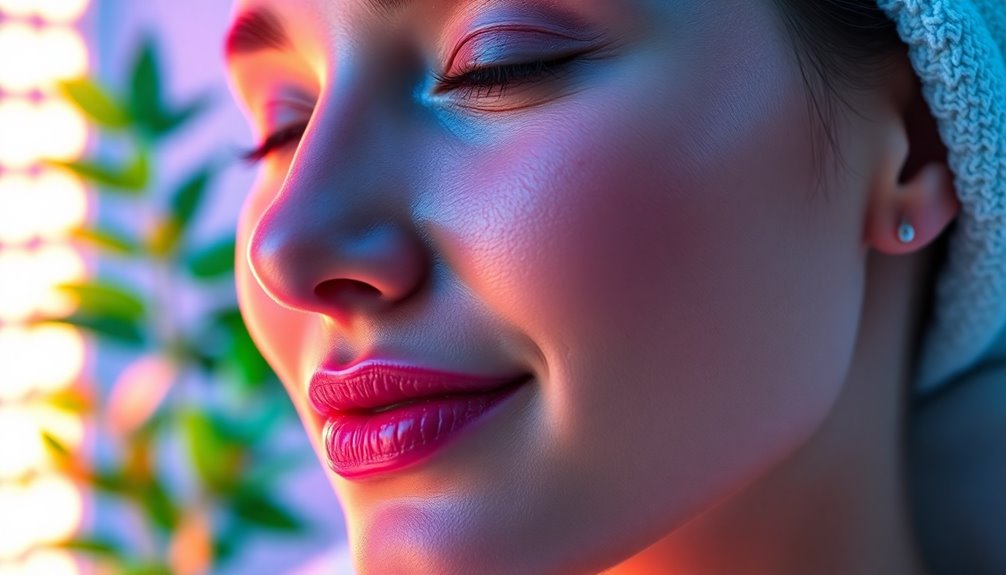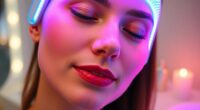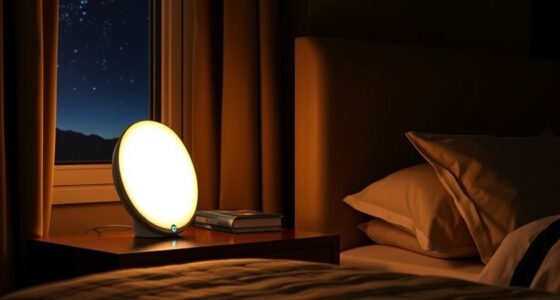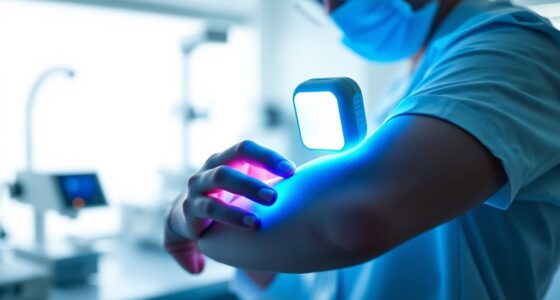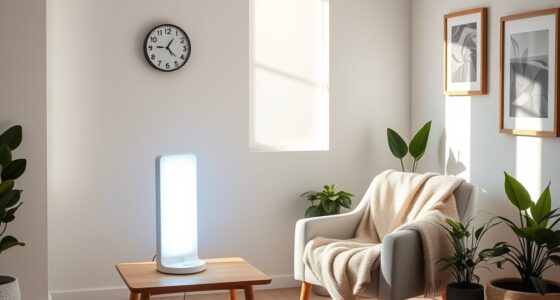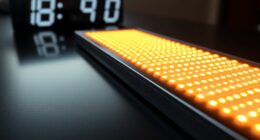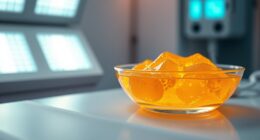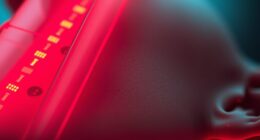LED light therapy improves your skin texture by boosting collagen production and aiding cellular repair. Red light stimulates collagen and elastin, helping to reduce fine lines and enhance firmness. Blue light targets acne by killing bacteria, which clears up your complexion. Near-infrared light increases blood circulation and speeds up healing, making your skin look revitalized. The treatment is non-invasive and tailored to your specific needs, ensuring safety while promoting a smoother skin surface. If you're curious about how to customize your approach or discover different light colors, there's plenty more to uncover.
Key Takeaways
- LED light therapy boosts collagen and elastin production, leading to firmer and more resilient skin texture.
- Red light specifically enhances skin elasticity and reduces fine lines, improving overall texture.
- Blue light effectively targets acne-causing bacteria, helping to clear skin and refine texture.
- Increased hydration from boosted hyaluronic acid levels promotes smoother and more supple skin.
- Anti-inflammatory effects reduce redness and irritation, resulting in a more even and radiant skin tone.
Benefits of LED Light Therapy
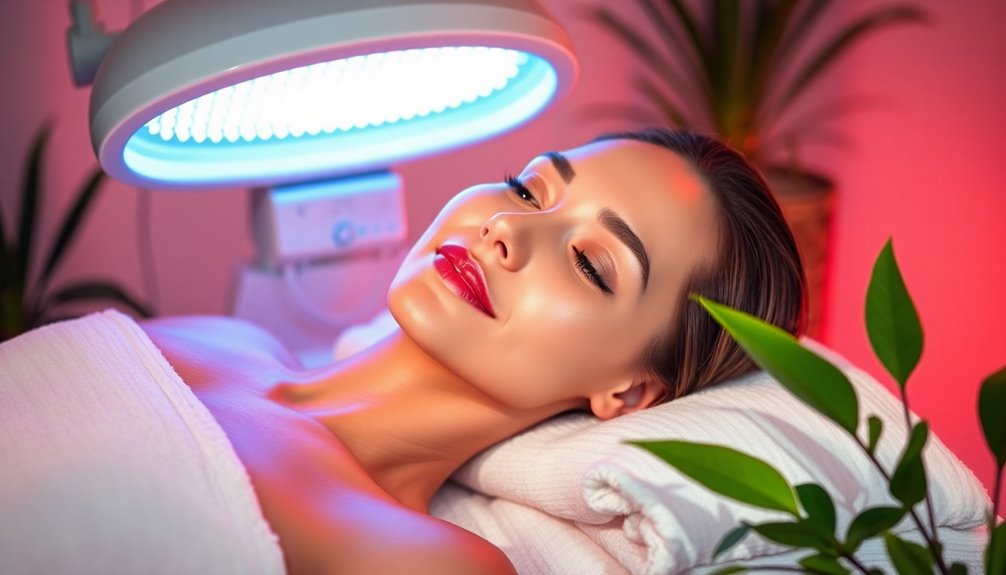
LED light therapy offers a range of benefits that can transform your skin. One of its standout features is its anti-aging properties. Red light stimulates collagen production, helping reduce fine lines and wrinkles while improving skin elasticity and firmness. It can even reverse sun damage, leading to a smoother complexion. Additionally, this therapy effectively stimulates collagen production in the dermis, further enhancing skin rejuvenation.
Additionally, if you struggle with acne, blue light therapy can kill acne-causing bacteria and regulate oil production, resulting in clearer skin. Regular treatments also enhance skin tone and texture, making your complexion more radiant.
Plus, these sessions are customizable, ensuring you address your unique skin concerns effectively. With its non-invasive nature, LED light therapy is a safe and powerful option for achieving healthier, revitalized skin. Additionally, the benefits of LED light therapy extend beyond surface-level treatment, as it can also promote collagen production and reduce inflammation. This advanced therapy is suitable for various skin types, making it an inclusive solution for anyone looking to enhance their skin’s appearance. Ultimately, incorporating LED light therapy into your skincare routine can lead to long-lasting improvements and a radiant complexion.
Types of LED Light Therapy
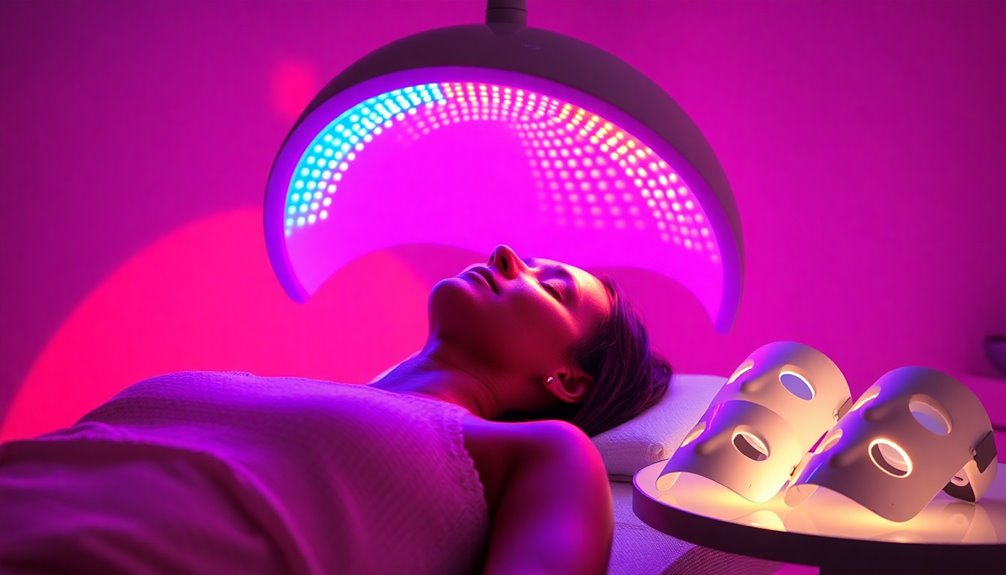
When it comes to enhancing your skin's texture, various types of light therapy can address specific concerns effectively.
Blue LED light therapy targets acne by reducing oil production and killing bacteria, leading to smoother skin.
Red LED light stimulates collagen production, improving elasticity and reducing fine lines, making it perfect for anti-aging. This treatment has been shown to enhance skin radiance and firmness for a youthful appearance.
Near-infrared light penetrates deeper, boosting cell permeability and circulation while speeding up healing and reducing wrinkles.
Green LED light focuses on pigmentation issues, evening out skin tone and promoting a uniform texture, though more research is needed to confirm its benefits.
Each therapy offers a non-invasive solution tailored to your unique skin needs, ensuring you achieve the results you're after.
Mechanisms Behind Skin Improvement
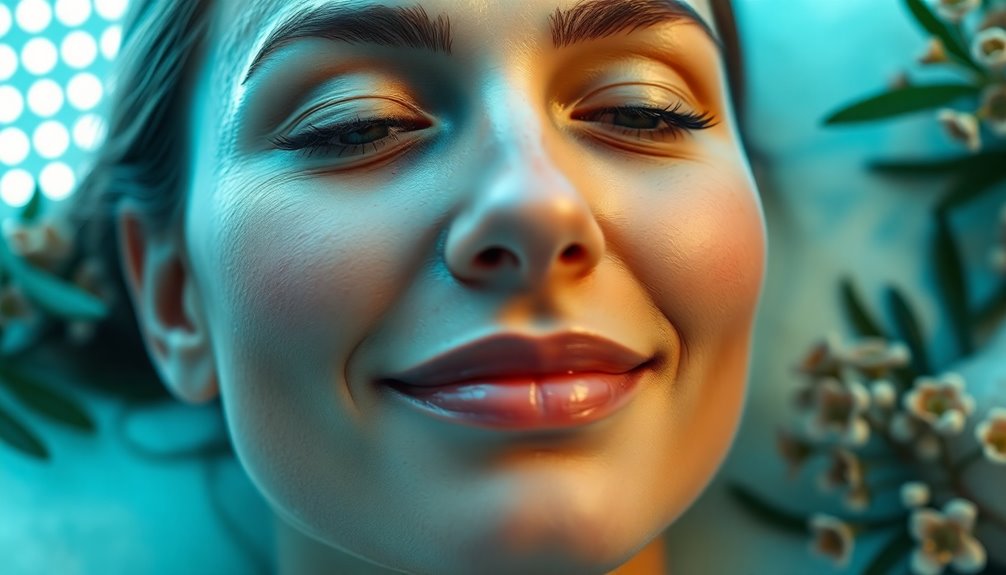
Understanding the mechanisms behind skin improvement can empower you to make informed choices about your skincare routine.
LED light therapy stimulates collagen and elastin production, enhancing skin firmness and elasticity. When red and near-infrared light penetrates deep into the skin, it activates fibroblast growth factors and increases ATP production, fueling collagen synthesis. This leads to reduced wrinkles and improved texture. Additionally, different wavelengths of light are used in LED therapy to target various skin concerns.
Additionally, LED therapy boosts hyaluronic acid levels, enhancing hydration and moisture retention, making your skin appear plumper. The anti-inflammatory effects of red light also promote healing and reduce redness, further contributing to a healthier complexion.
Clinical Evidence and Studies
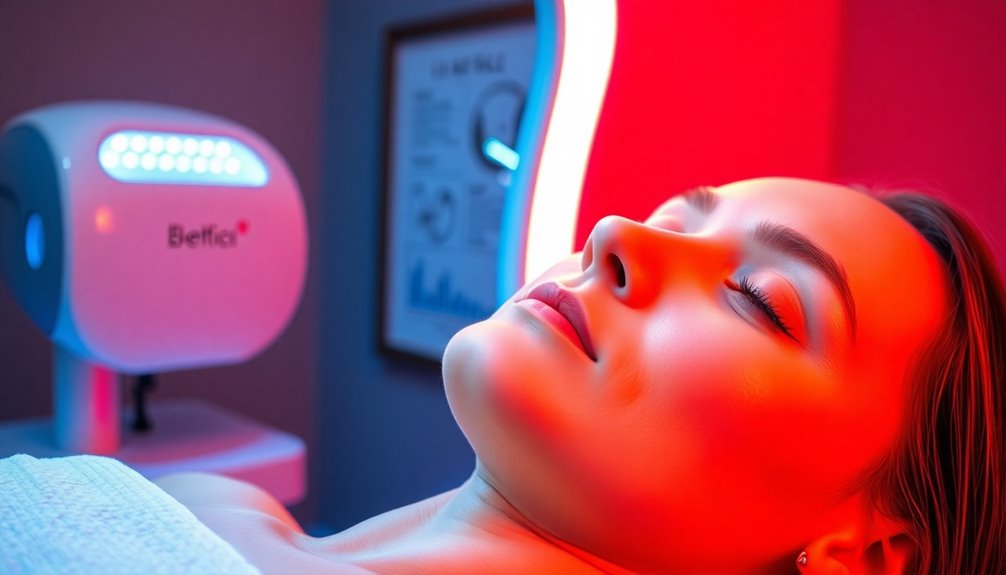
As research continues to unveil the benefits of light therapy, numerous clinical studies highlight its effectiveness in improving skin texture and overall appearance.
Red light therapy has been shown to stimulate collagen production, enhancing skin elasticity and reducing wrinkles. Near-infrared light therapy further promotes healing and increases blood flow, leading to firmer skin. Furthermore, a clinical study showed a significant increase in type-1 procollagen levels in subjects treated with LED light, demonstrating its potential to enhance skin structure.
Studies confirm that LED light therapy reduces inflammation linked to skin aging, improving overall skin tone. Additionally, clinical trials demonstrate that this therapy effectively reduces redness in conditions like eczema and rosacea.
Customizing Your Treatment Plan
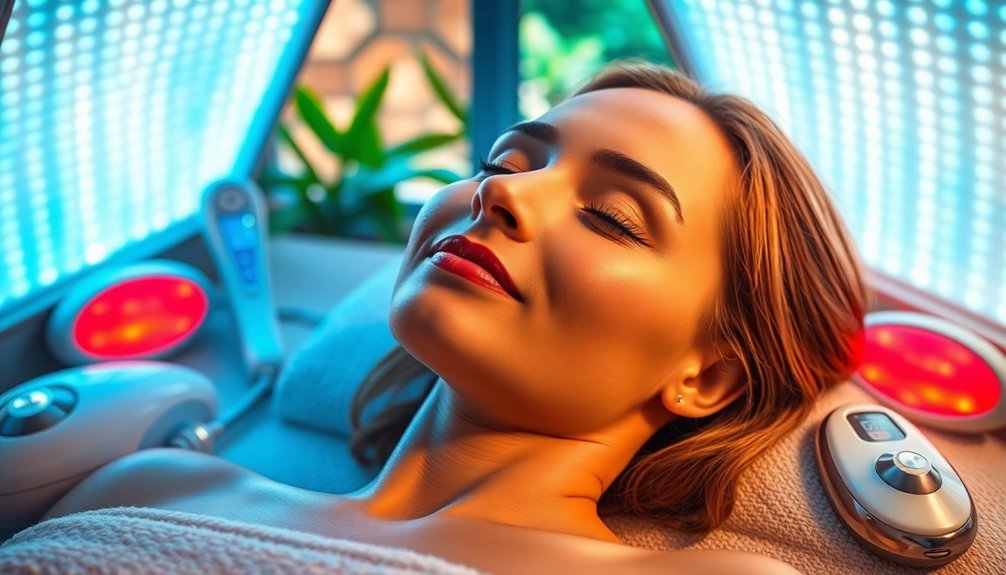
To achieve the best results from LED light therapy, it's essential to customize your treatment plan based on your unique skin needs and goals.
Start with a comprehensive consultation to gather your skin history, concerns, and identify your skin type. This helps in assessing any current conditions and contraindications.
Next, select the right LED wavelengths: blue for acne, red for anti-aging, and near-infrared for deeper tissue repair. Understanding light wavelengths is crucial for effective treatment.
Tailor the treatment's duration and frequency according to your skin type, adjusting for sensitivity when necessary.
Utilize advanced skin analysis tools to measure hydration and elasticity, ensuring data-driven decisions guide your treatment plan.
Continuously monitor your progress and make adjustments as needed for optimal results.
Frequently Asked Questions
How Long Does Each LED Light Therapy Session Last?
Each LED light therapy session typically lasts between 20 to 30 minutes, but it can vary based on the device and the area you're targeting.
For home use, sessions can range from 5 to 30 minutes, especially if you're a beginner. As you become more experienced, you might tolerate longer sessions.
Just remember to follow manufacturer guidelines and start with shorter durations to see how your skin responds.
Consistency is key!
Are There Any Side Effects From LED Light Therapy?
Are you wondering if LED light therapy has side effects? Yes, it can.
You might experience mild redness or dryness, especially after initial sessions. Some people also report swelling or itching, particularly those with sensitive skin.
Eye strain can occur if you don't wear protective goggles, and certain medications can heighten your skin's sensitivity.
Always consult with a healthcare provider to ensure it's safe for you, especially if you're on photosensitive medications.
How Often Should I Undergo LED Light Therapy Treatments?
You should undergo LED light therapy treatments 3 to 5 times a week for several weeks to see the best results.
For red light therapy, aim for 3 to 4 sessions weekly for 4 to 6 weeks, then switch to once or twice a week for maintenance.
Adjust the frequency based on your specific skin concerns, and always monitor your progress to find the right balance that works for you.
Can LED Light Therapy Be Combined With Other Skincare Treatments?
Yes, you can absolutely combine LED light therapy with other skincare treatments!
Pairing it with chemical peels can enhance results and speed up recovery.
When used alongside microneedling, it boosts collagen production and accelerates healing.
You'll find it complements facial treatments too, calming your skin and improving product absorption.
For acne treatments, it effectively targets bacteria and reduces inflammation, helping improve your overall skin texture.
Enjoy the benefits of these combinations!
Is LED Light Therapy Suitable for All Skin Types?
Absolutely, LED light therapy is like a magic wand for your skin!
It's safe for all skin types—whether yours is dry, oily, sensitive, or a mix. You won't have to worry about harmful UV rays or burns; it's non-invasive and customizable to your unique needs.
From treating acne to reducing inflammation, this therapy caters to various concerns, making it a versatile choice for everyone wanting to enhance their skin's health and appearance.
Conclusion
Incorporating LED light therapy into your skincare routine can significantly enhance your skin texture. Studies show that 80% of users notice visible improvements within just a few weeks. With various light types targeting different skin concerns, you can customize your treatment for the best results. By understanding the mechanisms at play and the clinical evidence backing this therapy, you can confidently embrace LED light therapy as a powerful tool in achieving radiant, youthful skin.
